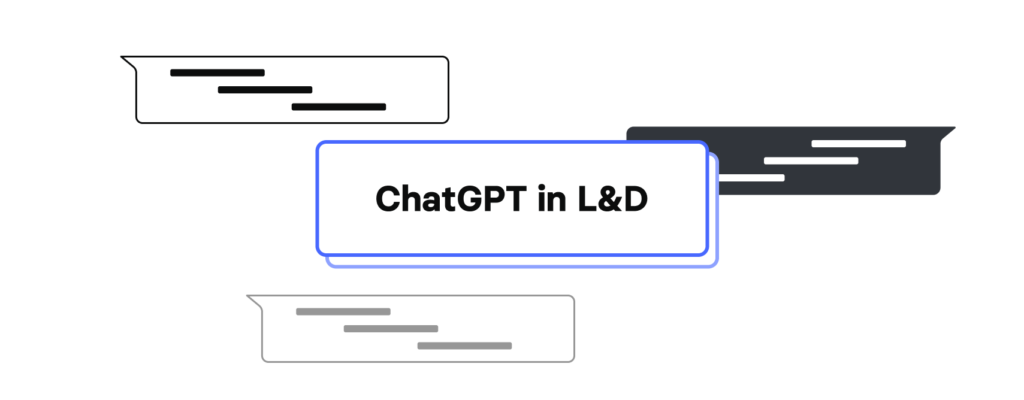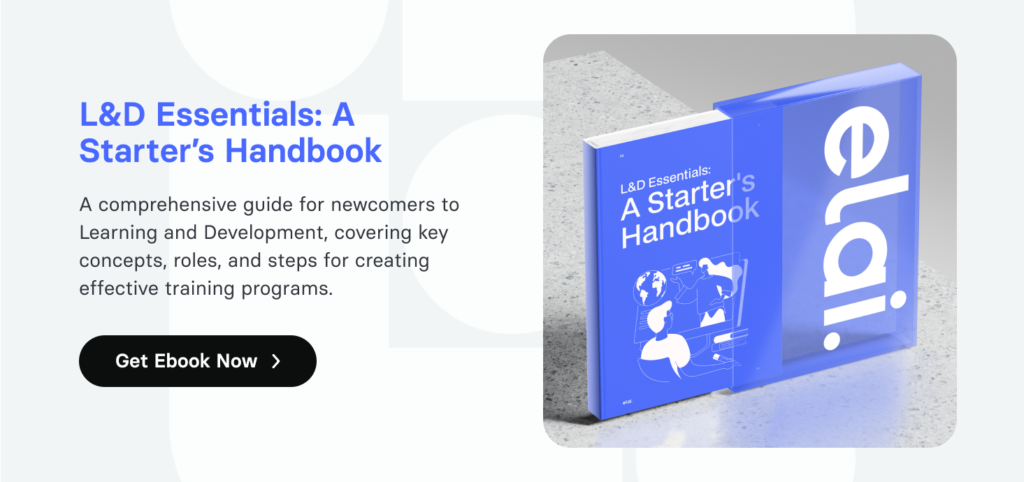In the realm of L&D and Instructional Design, the utilization of ChatGPT for prompting has become a game-changer. For instance, instead of spending long hours writing the script for the Training video, tools, like Elai.io have adopted ChatGPT technology in order to simplify our life. Their advanced AI technology can generate scripts from your topic, enhance your text, and add content to your scenes automatically, saving you time and effort. Other great tools useful for Instructional Design can be platforms like Midjourney or Lexica, which allow you to create perfect pictures for your course and you don’t have to worry about copyright.
Coming back to the topic of ChatGPT prompts for L&D, here are several other impactful ways in which prompting can be harnessed:
1. Inspiration and Ideas (incl. Gamification and Storytelling):
In the fast-paced world of corporate training, capturing the attention and interest of learners is paramount. By prompting ChatGPT with requests to provide you with ideas for training materials or to infuse the course with gamification or storytelling elements, L&D professionals can spark creativity and make learning more engaging. For instance, a prompt like “Give 10 ideas of a storytelling script for a scenario-based learning module for Compliance Training” or “Design a gamified module to teach project management skills, incorporating challenges and rewards” can lead to the creation of interactive and enjoyable training experiences.
Here is an example, where you can see a wide range of topics and scenarios, and even though they’re quite general and aren’t tailored perfectly for your case, it still gives you plenty of ideas to start your Course Development.
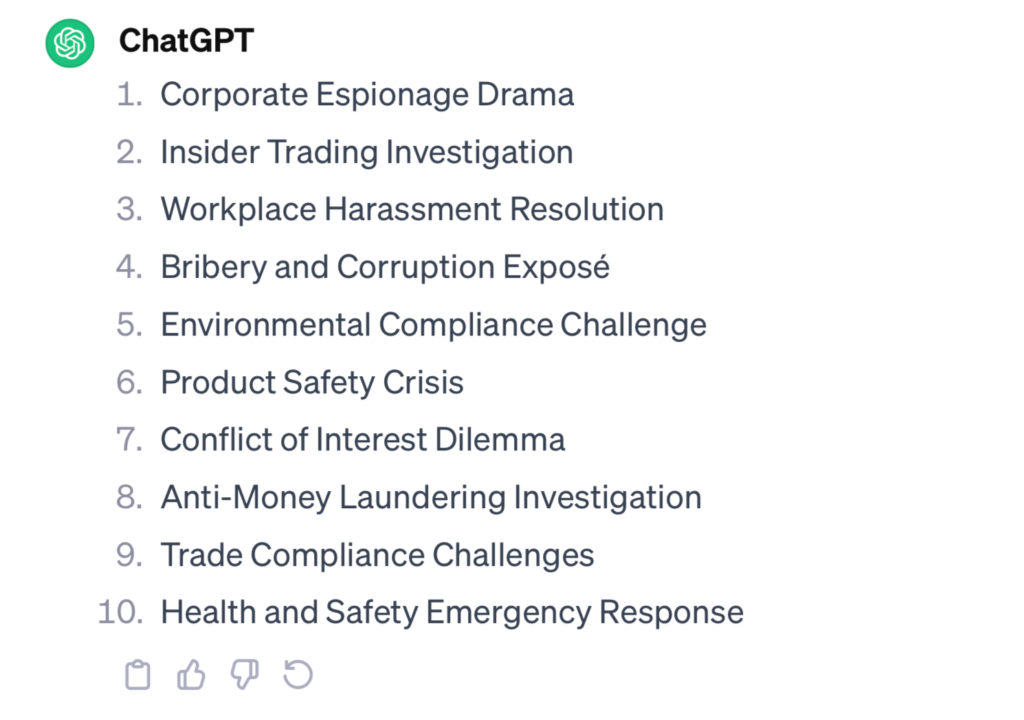
2. Create Dialogues for Role-Play Training or Scenario-Based Learning:
Role-play and scenario-based learning are powerful tools for practical skill development. By using prompts to generate realistic dialogues or scenarios, ChatGPT can aid in creating immersive training experiences that simulate real-world situations in a matter of seconds. Hence, ChatGPT prompts can be used for L&D video scripts as well. For example, a prompt such as “Generate a role-play dialogue for a customer service training session, focusing on handling customer complaints” will result in a lifelike script which can serve as a starting point for facilitating effective role-playing exercises:
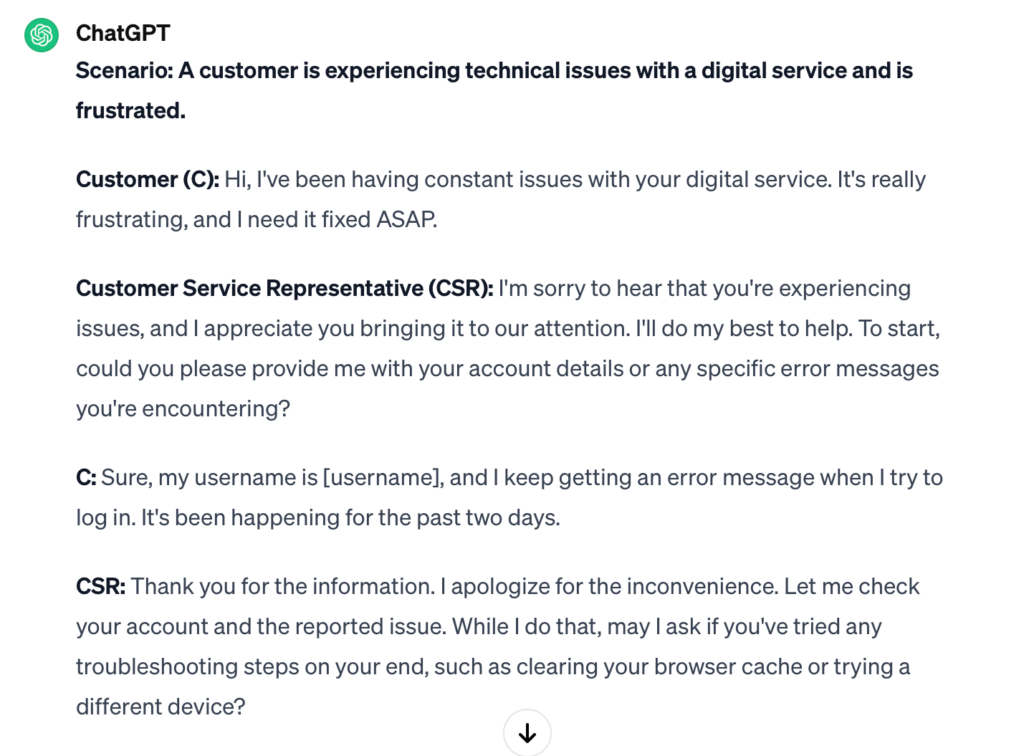
3. Grasp the Gist from Long Sources of Info:
In the age of information overload, getting key concepts efficiently is crucial. Prompts can be crafted to help ChatGPT summarize lengthy documents or articles, providing a quick overview that aids in the creation of concise and informative learning materials. For instance, a prompt like “Summarize a research paper on the impact of artificial intelligence in the entertainment industry for a training module” can help L&D specialists extract the essential information without overwhelming learners with unnecessary details.
4. Search for Mistakes in Content:
Quality assurance is paramount in developing effective learning content. L&D professionals can utilize prompts to engage ChatGPT in proofreading activities, identifying errors, inconsistencies, or inaccuracies in training materials. A prompt like “Review the content for a compliance training module and highlight any potential legal or factual inaccuracies” ensures that the learning materials meet the highest standards of accuracy and compliance.
5. Curriculum Design:
While creating a comprehensive curriculum, prompts can guide ChatGPT in designing tailored training plans. A prompt such as “Develop a comprehensive onboarding program for a multinational company with diverse teams” can help in creating a structured and inclusive curriculum that suggests ways to address the unique needs of a global workforce:
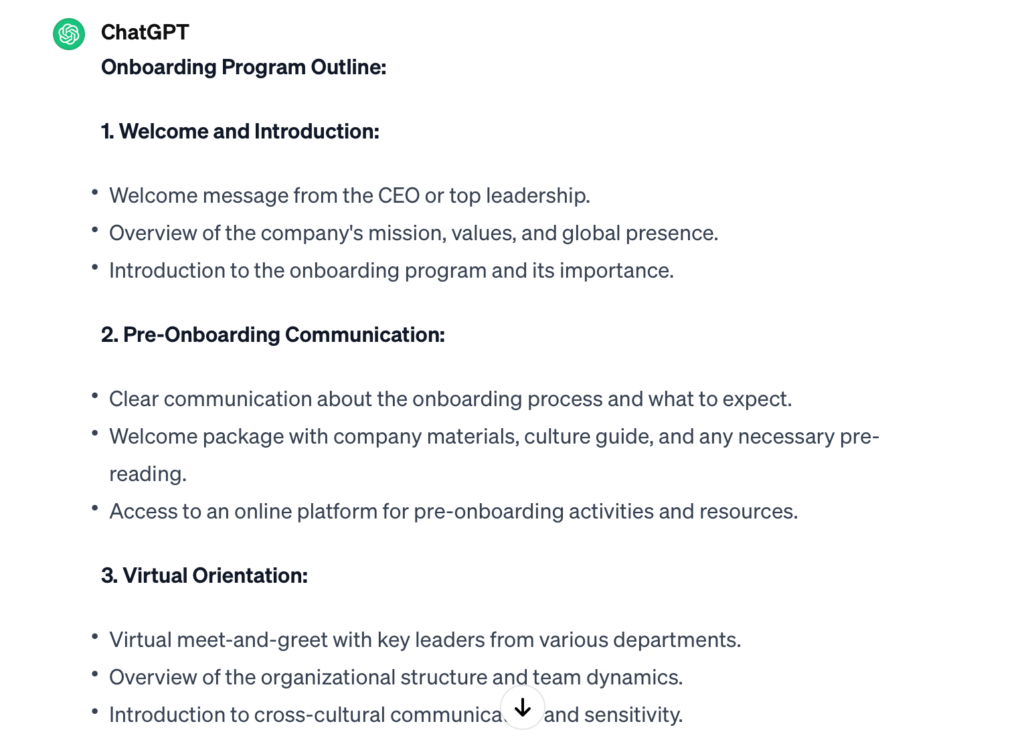
Navigating Potential Risks
While ChatGPT is a powerful tool, caution is vital when integrating it into Learning and Development processes.
Due to the potential for mistakes, it is advisable to avoid using ChatGPT as the sole creator of actual learning content. Human oversight is crucial to ensure accuracy, relevance, and alignment with learning objectives. While ChatGPT can generate ideas and provide inspiration, the final content should be thoroughly reviewed and refined by L&D professionals.
Avoid providing ChatGPT with sensitive or confidential information that you do not want to be disseminated digitally. Protecting organizational data and maintaining confidentiality should be a priority. It’s essential to be mindful of the information provided to ChatGPT, ensuring that only non-confidential and non-sensitive data is shared.
Better ChatGPT Prompting for Course Creation in Examples
Creating effective prompts is an art that requires precision and clarity. Let’s explore some examples illustrating the difference between poor prompts and improved prompts:
Poor Prompt: “Create a training program for financial professionals.”
Improved L&D Prompt: “Design an interactive e-learning course to enhance financial analysts’ risk assessment skills, incorporating real-world case studies.”
The difference between a poor and an improved prompt lies in specificity and clarity. The improved prompt provides clear direction, specifying the target audience (financial analysts) and the desired outcome (enhancing risk assessment skills). This ensures that ChatGPT generates content that is relevant and aligned with the intended learning goals.
Poor Prompt: “Create a module on teamwork.”
Improved L&D Prompt: “Develop an interactive e-learning module on fostering cross-functional teamwork in a virtual work environment, incorporating case studies and collaborative exercises.”
Explanation: The poor prompt lacks specificity regarding the context and activities. The improved prompt provides clear direction by specifying the context (virtual work environment) and including specific elements (case studies, collaborative exercises) to enhance the learning experience.
Poor Prompt: “Create a training program for employee development.”
Improved L&D Prompt: “Design a comprehensive employee development program focused on enhancing communication skills for entry-level customer service representatives.”
Explanation: The poor prompt lacks specificity, making it challenging for ChatGPT to understand the intended direction. The improved prompt provides clear guidance by specifying the target audience (entry-level customer service representatives) and the desired outcome (enhancing communication skills).
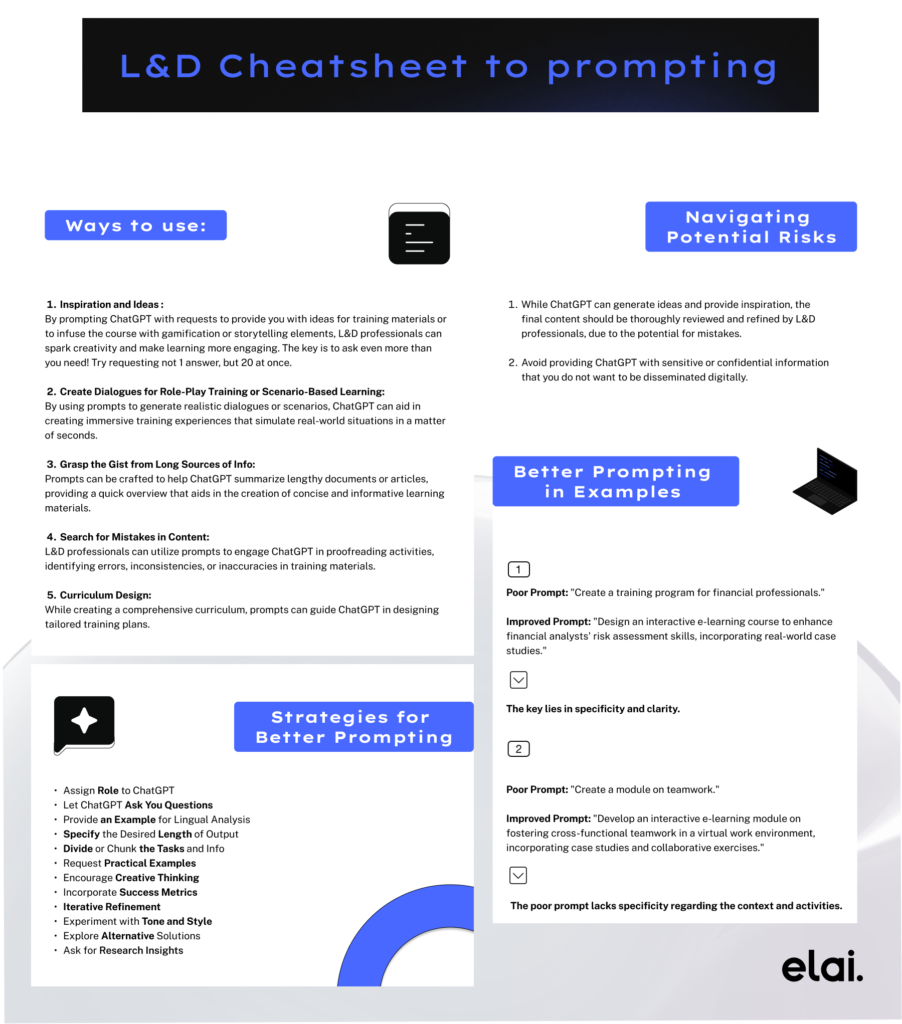
Strategies for Better Prompting
To maximize the effectiveness of prompting in L&D, consider the following strategies:
- Assign Role to ChatGPT
- Let ChatGPT Ask You Questions
- Provide an Example for Lingual Analysis
- Specify the Desired Length of Output
- Divide or Chunk the Tasks and Info
- Request Practical Examples
- Encourage Creative Thinking
- Incorporate Success Metrics
- Iterative Refinement
- Experiment with Tone and Style
- Explore Alternative Solutions
- Ask for Research Insights
To get a Framework for these Strategies with Practical Tactics and Examples click here.

Conclusion
Incorporating ChatGPT into Learning and Development practices offers immense potential for innovation and efficiency. By strategically prompting this powerful tool, L&D professionals can inspire creativity, design immersive learning experiences, and optimize their training programs. However, it is crucial to exercise caution, maintaining a balance between technological assistance and human oversight to ensure the highest quality in learning content. As the landscape of L&D continues to evolve, the effective use of ChatGPT through thoughtful prompting will play a pivotal role in shaping the future of education and skill development. By combining the strengths of artificial intelligence with human expertise, the learning journey can be elevated to new heights, ensuring a dynamic and effective educational experience for learners worldwide.
FAQ
How to Use ChatGPT for L&D?
Leverage ChatGPT in L&D by first defining your specific goals, whether it’s generating ideas or designing curriculum. Craft precise prompts aligned with these objectives to guide ChatGPT in producing relevant content. Collaboratively refine the results iteratively for improved quality, exploring the tool’s versatility across various L&D tasks. While ChatGPT is a powerful resource, combine its capabilities with human expertise to validate and refine the final content, ensuring a balanced and effective approach.
How to Write Prompts for L&D Video Scripts?
When crafting prompts for L&D video scripts, start by clarifying your objectives to guide ChatGPT in generating purpose-aligned content. Specify the desired tone and style, ensuring it suits your audience. Include key elements like characters and setting to provide context-aware output, and encourage creativity by prompting ChatGPT for imaginative dialogue aligned with your learning objectives. Finally, request varied script lengths to suit specific platform and content requirements, optimizing the use of ChatGPT for your L&D video scripting needs.
Can ChatGPT be used as the sole creator of learning content?
It is advisable to avoid using ChatGPT as the sole creator of actual learning content due to the potential for mistakes. Human oversight is crucial to ensure accuracy, relevance, and alignment with learning objectives.
How can ChatGPT assist in curriculum design?
ChatGPT can guide in designing tailored training plans through prompts. For example, a prompt like “Develop a comprehensive onboarding program for a multinational company with diverse teams” can help in creating a structured and inclusive curriculum.
What precautions should be taken when using ChatGPT in L&D?
Avoid providing ChatGPT with sensitive or confidential information. Protect organizational data and maintain confidentiality by sharing only non-confidential and non-sensitive data. Human discretion is essential.
What makes a prompt effective in ChatGPT usage?
Effective prompts are specific and clear, providing direction to ChatGPT. For instance, specifying the target audience, desired outcomes, and context ensures that the generated content is relevant and aligned with learning goals.
How can ChatGPT be used for quality assurance in learning content?
Prompts can be crafted to engage ChatGPT in proofreading activities, identifying errors, inconsistencies, or inaccuracies in training materials. For example, a prompt like “Review the content for a compliance training module and highlight any potential legal or factual inaccuracies” ensures high-quality content.
